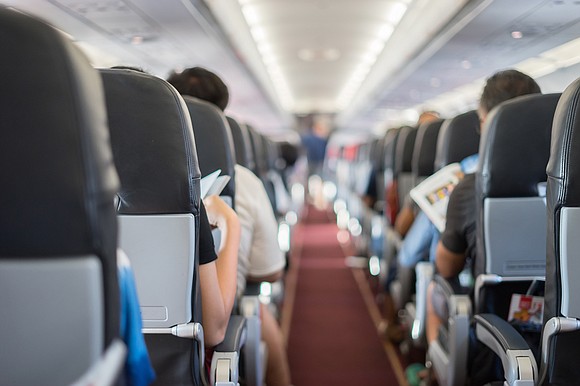Travelers have a lot to say about shrinking airplane seats
CNN/Stylemagazine.com Newswire | 11/4/2022, 4:46 p.m.

Originally Published: 04 NOV 22 16:48 ET
By Gregory Wallace and Pete Muntean, CNN
(CNN) -- Top-tier frequent flyer Rick Hubbard spends a lot of time squeezing into airplane seats and has noticed it's a tighter fit.
"Either that or I'm getting bigger and bigger, but I don't think so," Hubbard told CNN recently near a baggage claim. "I can't imagine seats or aisles being smaller than they are today."
Shrinking personal space in the skies is not imaginary: Experts say airline seats shrunk over the years while Americans grew larger.
Airlines are balancing passenger demand for cheap airfare and more legroom. Federal regulators, meanwhile, have focused narrowly on preventing a cabin so cramped that it prevents a rapid emergency evacuation.
"Their message to date has been how uncomfortable you are is between you and the air carrier," said Peter Goelz, a CNN safety analyst and former managing director of the National Transportation Safety Board.
Under pressure from Congress and passengers, the Federal Aviation Administration is now looking into whether seats are too tight to rapidly evacuate. Federal standards require evacuating a plane within 90 seconds of it coming to rest in an emergency, and a 2018 law requires the agency to rule on the minimum safe seat dimensions.
A flood of feedback
The agency opened up the seat size safety issue for comments this fall, and more than 26,000 comments poured in -- many raising concerns beyond evacuation.
Commenter John Naughton called "tiny seats terribly uncomfortable."
Jill Kenney predicted "less fights ... if people could fit in more comfortably."
Scott Parkinson, who is 6-foot-5, said jamming his knees into limited space leaves him "in pain for the entire flight."
He requested that "seats ... be placed further apart so people have a decent amount of leg room and your knees don't touch or crowd the seat in front of you" in the comment he submitted to federal officials.
The comments period closed on November 1. The FAA has not said whether it will act in response.
In official comments submitted to the FAA, the groups representing major US airlines -- Airlines for America and the International Air Transport Association -- urged the agency to stay focused on safety, "And Not Comfort or Convenience."
Cramped for shorter people, too
Paul Hudson, president of passenger advocacy group FlyersRights, says legroom isn't only an issue for the tallest passengers. He says shorter people can be uncomfortable, too, and cited data he submitted to the FAA associating health risks such as blood clotting with cramped conditions.
"They only narrowly define safety as if it has something to do with evacuation speed," he told CNN.
"But they ignore health risks, especially blood clots, which are known to increase dramatically when you're in a confined space for more than two or three hours. They ignore completely the forced intrusion that you have now on your neighbor."
Hudson says that since the FAA developed evacuation standards in 1967, the average American has grown about 30 pounds heavier and an inch or two taller. Airline seats, however, are smaller.
Airline seats are "the only area that we know of where the public is invited to sit in seats that have actually gotten smaller. Everything else -- stadium seats, theater seats, automobile seats -- have all gotten larger," Hudson explained.
FlyersRights proposed the FAA require 32 inches of pitch -- commonly measured from one seat back to the back in front of it -- and more width. It says those dimensions will fit more than 90% of Americans.
Studying seat size
In 2019, the FAA loaded people into an aircraft cabin to test evacuation speeds with differing legroom.
Stacey Zinke-McKee of the FAA's Civil Aerospace Medical Institute told CNN at the time that the study was needed to "first decide if it's a safety issue -- if there's any safety concerns."
The study concluded that "currently flying seat pitches ... can accommodate and not impede egress for 99% of the American population."
But US Rep. Steve Cohen, a Tennessee Democrat who wrote the legislation that spurred FAA action, called the testing "as faulty as they could be."
"They had nobody under 18, nobody over 60, nobody with a disability, nobody with a walker, nobody with a seeing eye dog, nobody with any kind of dog at all, nobody with luggage," he said.
"The public safety should be first and foremost, and it's not," Cohen said.
The FAA and Department of Transportation declined CNN's request for an interview.
The airline perspective
Airlines for America said its members consider safety the "top priority."
"Airlines continue to invest in a wide range of innovative technologies to maximize personal space in the cabin while maintaining a level of comfort passengers expect," the group said in a statement.
It told the FAA thinner and redesigned seats mean that "despite the reduction in the seat pitch, in the majority of cases passengers still have the same or near equivalent amount of space, and in some cases more space for their legs and knees."
One airline recently announced that it is ordering planes with larger seats. Spirit Airlines said rows on its new Airbus aircraft feature "innovative curved seatback designs that unlock space at the knee level" -- about two additional inches.
The seats will also be wider. How much wider? A half inch.






